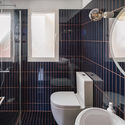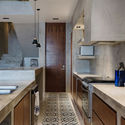
Square, rectangular, hexagonal, matte, shiny. It's hard to think of a more versatile flooring material than tiles. They're also known for their high durability, ease of maintenance and installation, and are among the most common choices for covering floors and walls, whether wet or not. Following are 10 common questions about ceramic tiles, and their answers:
1. What is the difference between ceramic and porcelain?
The fundamental difference between ceramic tile and porcelain tile lies in the technology behind their production. Porcelain is the result of a more controlled manufacturing process than ordinary ceramics, made through a mixture of porcelain and various minerals burned at over 1200 degrees Celsius. The resulting material is more homogeneous, dense, vitrified, and resistant than conventional ceramics. It is also less porous and therefore has a very low water absorption index, making it more durable as well. This feature makes it suitable for high traffic locations such as airports or shopping malls. Porcelain glazes are also known for their greater color variation, providing a rich custom look.

Ceramic, in turn, is composed of a mixture of clay and some minerals. Due to the slight variations and irregularities, it may yield a more interesting aesthetic result.
2. What types of finishes exist?
The finish refers to the upper surface of the tile's coating and can be polished, shiny, satin, matte, or natural.

3. Is ceramic tile a durable material?
Yes, but this depends heavily on the installation. To optimize durability, the subfloor or base on which the tiling will be glued must be flat, stable, and without irregularities. Depending on the dimensions of each tile, the proper mortar must be used. For larger pieces, manufacturers recommend double gluing on the subfloor and the back of the tile. Generally, carefully following the manufacturers' recommendations is always the best thing to do.

4. What is a rectified tile?
Rectified tiles go through a cutting process called grinding, which trims all pieces to the same exact size. As a result, seating joints can be minimal, reducing the amount of grout and making the assembly more aesthetically pleasing.

5. How do I calculate the number of tiles I need?
Of course, you will need to know the area of the space. But you should also plan to start with more than the exact number of tiles that will fill the area, due to breaks and cutouts. Generally, adding 5 to 7% in surplus to account for cut loss is sufficient if the environment is simple (square or rectangular with few cutouts). If the plan is diagonal or if the environment has a distinctive or organic shape, then many pieces will have to be cut at the corners. In these scenarios, it is important to provide a surplus of up to 15% to avoid material deficit during installation.

6. Can floor tiles be installed on walls? Or wall tiles on floors?
Virtually any floor tile can be installed on the wall, though in most cases, it is not appropriate to switch them. Consult the installer or product manufacturer for application recommendations.

7. Can I install tiles on top of other tiles?
Usually, yes, but only if the surface below has been installed correctly and is not broken or experiencing any problems, such as stuffing. However, this is generally not the smartest option, and though initially cost-saving may later incur higher costs. Keep in mind that overlapping floors will slightly decrease the height of the room, and that the doors will have to be altered to open normally.

8. Are ceramic tiles non-slip?
To know whether or not a tile is non-slip, it is important to know its dynamic friction coefficient, which is an index of slip resistance. The higher the number, the more 'non-slip' the piece. Each country has its own norm in this regard. In Brazil, for example, manufacturers follow the Brazilian standard of 13818/97, which divides parts into two classes:
-
Class I - Coefficient less than 0.4 - Indoor areas only;
Class II - Coefficient greater than or equal to 0.4 - Can be used outdoors and are safer for shower stalls, for example.


9. How do you cut and pierce tiles?
For straight cuts, a special tool is generally used that scratches and then cuts the tile, creating a clean cut and good finish. For other details or clippings, a disk saw can be used. It is important to use the proper disc for a satisfactory finish on the tile. To create holes, the ideal method is to hire a specialized technical team to avoid cracking.

10. Is it possible to paint on tiles?
Yes, but not all paints work. In the case of highly waterproof and smooth surfaces, the paint should be highly adhesive, for which manufacturers recommend epoxy paint. It is also necessary to prepare the base, following the directions of the product packaging.























